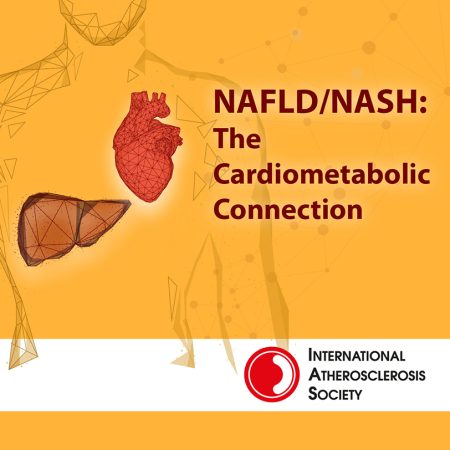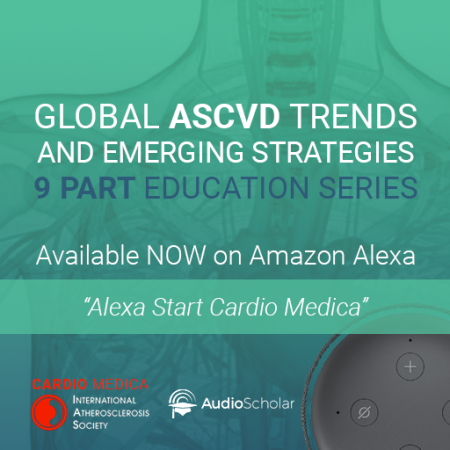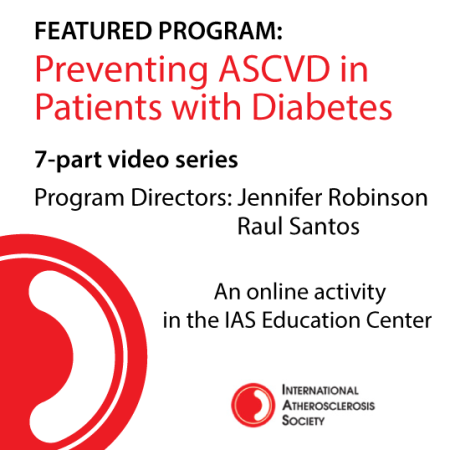
NAFLD/NASH: The Cardiometabolic Connection
The prevalence of non-alcoholic fatty liver disease (NAFLD), is the main hepatic complication of postprandial dysmetabolism, obesity, type 2 diabetes mellitus (T2DM), and the metabolic syndrome. Its emergence has risen dramatically since 1980, when it was a perplexing and sporadically observed disease to a current estimated 25% global prevalence.
Its strongest risk factors are like those of ASCVD. Issues currently arise with diagnosis, lack of treatment options and the multifactorial nature of the disease. The challenge for clinicians, payers and public health officials grappling with the condition is thus to identify who among those with NAFLD have greater chance of liver disease progression, development of ASCVD and therefore are at greatest necessity to treat.
This program presented by the International Atherosclerosis Society (IAS) was funded by educational support from Pfizer Pharmaceuticals. Detailed information on the faculty, disclosures, and additional available references or to tke this program online, visit the IAS Education Center.
The programs previously offered have now expired on CardioMedica (Alexa). Please visit the IAS Education Center at www.athero.org to access online versions of this education offering.

GLOBAL ASCVD: TRENDS AND EMERGING STRAEGIES
The IAS has developed the worldwide effort aimed at health care professionals to comprehensively address the matter of LDL-C attributable risk in the prevention of Major Adverse Cardiology Events (MACE) and mortality This will be accomplished through a series of nine (9) videos presented by some of the most recognizable and prominent leaders in cardiology and lipid medicine from across the globe.
Importantly, the videos will emphasize the translation of current guidelines and evidence into practice approaches that heighten both clinical and patient success. Every video, based on real-world issues and evidence, will focus on implementing practical physician and patient strategies.
The programs previously offered have now expired on CardioMedica (Alexa). Please visit the IAS Education Center at www.athero.org to access online versions of this education offering.

Preventing Atherosclerotic Cardiovascular Disease in Patients with Diabetes Mellitus
The IAS recognizes that system-level improvements are needed in the prevention of ASCVD in patients with diabetes and that progress in CVD risk factor control is slowing. Based on US data, only 14% of patients meet targets for all A1C, BP, lipids, and nonsmoking status. 33-49% of patients still do not meet one or several targets for A1C, blood pressure, or lipids. This problem is exacerbated globally as even fewer meet these targets in many low-and middle-income countries.
The purpose of this video series are to provide a better understanding of the evidence-based management of the diabetic patient to reduce ASCVD risk with focused discussion on statins and newer diabetes drugs. Each section is introducted by general lecture of the clinical prevalence and evidence. The panel will discuss the real world implications and provide practical implemtation advice.
The programs previously offered have now expired on CardioMedica (Alexa). Please visit the IAS Education Center at www.athero.org to access online versions of this education offering.
Alexa Says” Welcome, if you would like to start a program say Begin”
OPTION 1: Just say “BEGIN“
Alexa will play the most recent program uploaded.
When done you can continue in date order to other programs sorted by release date.
OPTION 2: To play a specific program by Keyword.*
AFTER ALEXA ASKS FOR YOU TO SAY BEGIN, YOU SAY “KEYWORD XXXX“
You can find the program keyword in the program drop down menu.
OPTION 3: You want a specific module within a program, then use a “Catalog Number”
AFTER ALEXA ASKS FOR YOU TO SAY BEGIN, YOU SAY THE “CATALOG NUMBER”.
You can find the program catalog number in the program drop down menu.
You can download the app for your computer or mobile phone.
Windows– Download the Alexa app in the Microsoft Store
Android- The Alexa app can be found in the Google Play Store
Apple- The Alexa app can be found in the App Store
All programs are created for Audio and Video playback. If you have a device without a screen or are streaming by bluetooth, you can still listen to the audio presentations.
All programs are created in English and avaialble in countries that provide Alexa services in English only.
Alexa listens for standard phrases that allow it to be interactive and Cardio Medica uses standard Alexa commands.
At key points in the program Alexa will prompt you for the desired response. Like please say “yes or no“,” true or false” or to give a short answer to a multiple-choice question like “A”, “B”.
Note: If you are in place with background noise, Alexa may not understand what you are saying, she will ask again or exit the skill when given a confusing answer.
· Alexa Start Cardio Medica—Starts the skill
· Alexa Begin– Starts the requested program
· Alexa Stop or Alexa Pause – Pauses the audio
· Alexa Play or Resume– Resumes the Audio
·Alexa Cancel– Ends Cardio Medica
· Alexa Forward “XXX” seconds(or minutes)- Jumps forward in the Audio
·Alexa Back “XXX” seconds(or minutes)- Jumps back in case you missed something.
·Alexa Next- When the audio or video portion is finished use this command to move forward.
Please email us using the contact form and describe your issue which can help improve this technology.